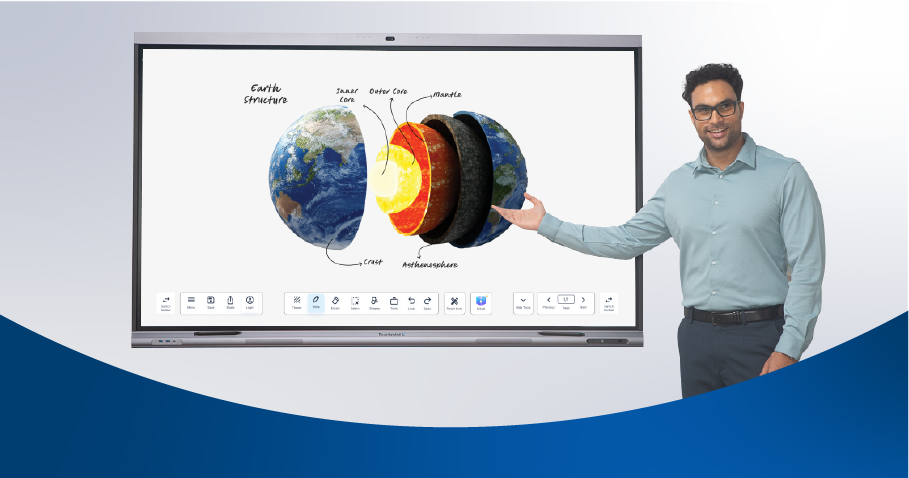A digital board, in the context of education, is a technologically advanced tool that fosters dynamic and engaging learning environments. These boards are touch-sensitive screens that allow students and educators to interact with content through gestures, styluses, or other digital tools. Digital Boards are increasingly becoming a staple in modern classrooms, replacing traditional blackboards and whiteboards with their versatility, interactivity, and integration capabilities.
Features of Digital Boards in Education
Digital Boards are designed to enhance teaching and learning experiences through their advanced features. Some of the most prominent features include:
- Touchscreen Interactivity: Students and teachers can interact directly with the screen by touching it, making lessons more engaging. Multi-touch capabilities allow multiple users to interact with the board simultaneously.
- High-Resolution Display: With high-definition or even 4K resolution, digital boards provide clear, vibrant visuals, making it easier for students to view and understand complex concepts.
- Compatibility with Educational Software: These boards can integrate with a variety of educational tools and software, such as virtual labs, 3D modeling applications, and online learning platforms.
- Built-in Apps and Tools: Many boards come preloaded with applications like digital whiteboards, annotation tools, and multimedia players to facilitate diverse teaching methods.
- Wireless Connectivity: Teachers can connect their devices, such as laptops, tablets, or smartphones, to the board wirelessly, enabling seamless content sharing.
- Accessibility Features: Many digital boards include options for students with disabilities, such as voice commands, text-to-speech, and adjustable screen settings.
Benefits of Digital boards in Education
The adoption of digital boards has transformed the traditional classroom, bringing numerous benefits to both teachers and students. Here are some of the key advantages:
1. Enhanced Engagement
Digital boards make learning more engaging by incorporating multimedia elements such as videos, animations, and interactive quizzes. This keeps students interested and motivated, especially when compared to traditional lecture-based teaching methods.
2. Facilitates Collaborative Learning
Digital boards encourage group activities and teamwork. For example, students can work together to solve problems, create presentations, or participate in interactive games. The ability for multiple users to interact with the screen simultaneously fosters a collaborative environment
3. Personalized Learning
These boards support diverse learning styles by allowing educators to tailor their lessons to meet individual student needs. For instance, visual learners can benefit from diagrams and videos, while kinesthetic learners can interact with the screen to understand concepts better.
4. Immediate Feedback
Digital Boards often include tools for instant assessment, such as quizzes and polls. Teachers can quickly gauge student understanding and adjust their lessons accordingly.
5. Integration with Digital Resources
The boards can connect to the internet, giving teachers access to a vast array of online resources, such as e-books, educational videos, and interactive simulations. This integration enriches the curriculum and keeps it relevant to real-world applications.
6. Improved Accessibility
For students with special needs, digital boards offer various assistive technologies. Features like screen magnification, voice control, and closed captioning ensure an inclusive learning environment.
7. Streamlined Lesson Preparation
Teachers can save time by preparing lessons in advance and storing them on the board or in the cloud. This feature also allows educators to reuse and refine their materials over time.
Applications of Digital Boards in the Classroom
Digital Boards have a wide range of applications in education, catering to different subjects and age groups. Here are a few examples:
1. STEM Education
Digital Boards are ideal for teaching science, technology, engineering, and mathematics (STEM) subjects. Teachers can use simulations to demonstrate scientific experiments, 3D models to explain engineering concepts, and interactive graphs for math problems.
2. Language Learning
Language teachers can utilize digital boards for activities like vocabulary games, pronunciation practice, and collaborative writing exercises. Real-time translation tools can also help in teaching foreign languages.
3. Art and Design
For creative subjects like art and design, students can use digital drawing tools and design software directly on the board. This fosters creativity and allows for immediate feedback from teachers.
4. History and Geography
Digital Boards can bring history and geography lessons to life with virtual field trips, historical reenactments, and interactive maps. These tools make abstract concepts more tangible and memorable.
5. Special Education
Students with special needs can benefit greatly from digital boards. Teachers can customize lessons to accommodate different learning paces and abilities, making education more inclusive.
Challenges and Considerations
While digital boards offer numerous benefits, there are challenges to consider:
1. Cost
The initial investment for digital boards can be high, which may be a barrier for some schools. However, the long-term benefits often outweigh the upfront costs
2. Training Requirements
Teachers need adequate training to use digital boards effectively. Professional development programs are essential to ensure that educators can maximize the potential of these tools.
3. Technical Issues
Like any technology, digital boards can face technical issues, such as connectivity problems or software glitches. Schools need to have reliable technical support to address these challenges promptly.
4. Screen Time Concerns
Excessive screen time can be a concern for younger students. Educators should balance the use of digital boards with other teaching methods to ensure a holistic approach to learning.
The Future of digital boards in Education
As technology continues to evolve, the capabilities of digital boards are expected to expand. Artificial intelligence (AI) and machine learning could be integrated to provide even more personalized learning experiences. For example, boards could analyze student performance data to recommend tailored learning resources.
Furthermore, augmented reality (AR) and virtual reality (VR) could be incorporated into digital boards, offering immersive learning experiences. Imagine students exploring ancient civilizations or dissecting virtual organisms right from their classroom.
Conclusion
Digital boards represent a significant step forward in educational technology, offering dynamic and versatile tools to enhance learning experiences. By promoting engagement, collaboration, and accessibility, these boards empower both teachers and students to achieve their full potential. As educational institutions continue to adopt these technologies, the future of learning looks more interactive, inclusive, and innovative than ever before.




